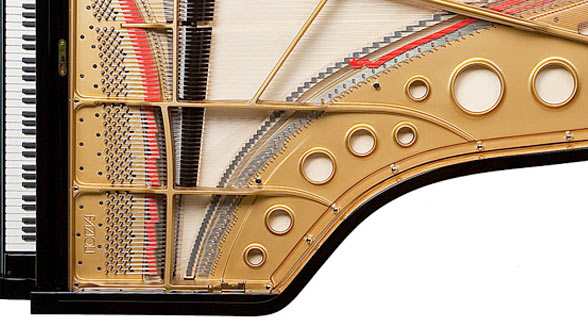Steinway or Fazioli?
The sound of a concert grand piano is something to behold. If you’ve never had the chance to hear one up close, you owe it to yourself to visit a piano salesroom for the experience. Just sit down on the bench and play a single note. Play one up high on the keyboard, in the middle and then down low. Play a chord of three notes.
The piano is one of the most developed music instruments ever constructed. There are nearly 20 individual parts associated with an individual key. And each note (there are 88 on most pianos…Bösendorfer adds three more at the bottom end!) strikes either two or three strings that are stretched across a wooden bridge and held by a steel frame. Pianos are marvels of mechanics and musical mastery.
And they all sound different! Even the same model by the same maker coming from the same factory will have variations in their feel and tonal characteristics. Purchasing a piano is not something that will ever be done over the Internet. Pianists have to visit the factories or retailers and play a number of instruments before one will speak to them. World-class touring artists travel with a couple of instruments or at least insist on a particular make and model at their performances.
I have recorded most of my projects in a 300-seat concert hall in downtown Los Angeles. The hall is called Zipper auditorium. It’s one of the recital spaces at the Colburn School for the Performing arts. I absolutely love the acoustics of this space and musicians enjoy the rich ambiance that is reflected from the ceiling and walls. And they have a couple of very fine concert grand pianos.
I’ve grown very partial to the 9-foot Steinway Model D instrument that lives in Zipper Hall. It’s well maintained, beautiful to look at and produces a variety of tonal colors that range from deep resonant bass to “pearly” high notes. The midrange is clear and open sounding with balanced registration. This is a first class instrument and I look forward to hearing it played by a first class musician like Bryan Pezzone or Delores Stevens.
But the folks at the Colburn School have another instrument in the same closet that houses the Steinway. An Italian company named after its founder pianist and engineer Paolo Fazioli makes the alternate piano. I had the pleasure of meeting this remarkable man during a musical instrument convention many years ago. I was fascinated by his knowledge of music and technology. He possesses tremendous knowledge about music AND the latest manufacturing techniques and computer aided design software. His instruments reflect his passion for the music and the beauty of the physical instrument.
The availability of the Fazioli at Zipper Hall intrigued me to the point that I had to use it for one of my recordings. We left the valued Steinway in the closet and rolled the Fazioli out onto the stage. Now I’m not a great pianist but I did study piano for about 5 years and managed to get through music school as a composer who played enough piano to graduate. I got to learn some Bach (my favorite), Beethoven, Chopin, Dahl and Debussy among others so I can get around on the instrument. I sat down at the Fazioli and I played for about 10 minutes. And I let the artist that I was going to record that day play as I walked around the instrument listening to the timbres and tones that were being produced. It was gorgeous.
But it was not the sound that I personally associate with a concert grand. It was my personal taste and I guess my tonal memory that made me choose the Steinway over the Fazioli. There was just something about the Steinway tonal characteristics that worked for me. Others with equally valued opinions may choose the Fazioli brand. I notice Herbie Hancock’s note of congratulations on the Fazioli site. The company is doing well in a world that has moved into electronic instruments that recreate the sound of a piano…or try to.
Listening to music played back by from vinyl, analog tape, DSD files or HD-Audio PCM can be appreciated and preferred by music lovers. And those of us that know something about the technology involved in capturing and reproducing sound using various formats might have a soft spot for formats that deliver a less colored version of the sound. But at the end of the day, you get to choose what you like. Both the Steinway and Fazioli pianos are finely crafted and in the hands of a terrific artist produce amazing music.
As a recording engineer, producer and musician, things are little tougher in the world of recording and reproducing music because not all formats are capable of the same level of accuracy, dynamic range, frequency response and “realism”. In the final analysis, I consider myself a craftsman that uses the tools of my trade, knowledge of music and acoustics and 40 years of experience to produce uncompromised recordings. Check out the free samples and see if you enjoy the AIX Records sound.

